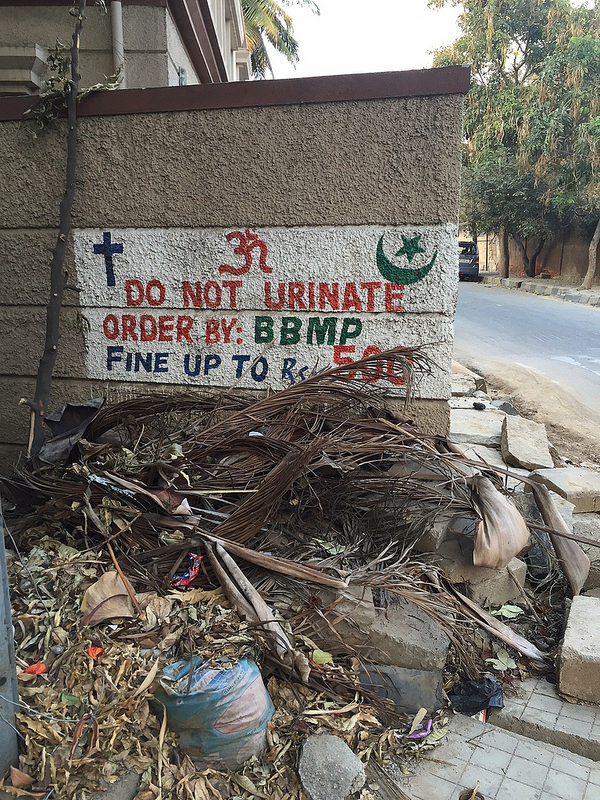Trending Now
- 830 voters names go missing in Kavundampalayam constituency
- If BJP comes to power we shall consider bringing back electoral bonds: Nirmala Sitaraman
- Monitoring at check posts between Kerala and TN intensified as bird flu gets virulent in Kerala
Columns
My garbage is now my concern: Why Bengaluru is changing its attitude towards waste segregation
![]() March 7, 2016
March 7, 2016
Janaki Murali
In last week’s ranking of 73 cities, the Swacch Survekshan survey commissioned by the Ministry of Urban Development ranked Bengaluru a dismal 35, a steep drop from its rank of seventh cleanest city in 2015.
In a span of just one year, Bengaluru’s garbage problems have not only brimmed over, but have resulted in the city earning a new sobriquet: garbage city.
Why has garbage become such a huge crisis in this technology capital?
Several factors have led to this mess. A clueless Bruhat Bengaluru Mahanagara Palike (BBMP) groping in the dark for solutions, the strong truckers/contractors lobby, and a general apathy among citizens. If today, the stakeholders are scrambling to find sure-fire and quick solutions, it’s “too little, too late.”
The crusading zeal that put Bengaluru on the world map as a buzzing IT hub, got blunted somewhere along the way. Bengaluru-based Indian corporates like Infosys and Wipro led the march to NASDAQ, creating jobs for thousands of young engineers from India’s villages. Conversely, this also led to the unbridled expansion of the city’s limits and growth in population from 4. 3 million in 2001 to 9. 6 million in 2011.
Nobody expected Bengaluru to burst at its seams, least of all its city’s planners.
Meanwhile, mesmerised by the high rises, gated communities, state-of-the-art hospitals and mammoth malls showcasing Bengaluru’s growing wealth, its citizens too chose to ignore the growing pile of garbage in their backyards. Bengalureans expected municipal authorities to take charge of their garbage, with the nonchalant air of “my garbage is your concern.”
In short, Bengalureans chose to ignore the elephant in the room.
And, life would have trudged along in its normal pace, if only BBMP could have continued to send the city’s garbage to landfill sites, keeping the powerful contractors and truckers’ lobby happy too. With 500 trucks carrying garbage to landfills daily, it meant, the further the truckers drove, the more they got paid. But nobody factored in villagers from landfill sites to raise a stink. Mandur was the first village to protest, followed by S. Bingipura.
To be fair to the BBMP, it took several initiatives to reduce, recycle and reuse waste. It issued orders that every household had to segregate its waste and that the 14,000 Pourakarmikas it employed would only pick up segregated waste. But what happened in reality was that even if households were segregating the waste, it was mixed at collection points. BBMP started relying on its waste processing units to clear this mixed garbage.
Once again, protests from residents of some 500 villages, including Gundlahalli of Doddaballapur taluk and Chigaranahalli of Koratagere taluk, home to two waste processing units, put the BBMP on the back foot. Residents of these villages complained that BBMP had promised to send only wet waste to these processing units, but instead was sending mixed waste.
By October 2015, the garbage crisis had figured in the Legislative Assembly session. Bengaluru Development Minister KJ George stated in the Assembly that the government was calling for fresh garbage collection tenders in 95 wards in an effort to end the reign of the “garbage mafia”. He also added that the government would take strict action against contractors who continued to mix dry and wet waste.
In November 2015, more citizen protests added to the growing voice of dissent, at another waste processing plant- this time, inside the city .
What changed things on the ground was a landmark ruling from the High Court in December 2015. Citizen’s initiatives of several citizens’ forums, eco retailers, garbage service providers and organic waste solutions got a boost when the High Court ruled on the Public Interest Litigation filed by the Solid Waste Management Round Table, calling waste a resource. The HC ruling addressed three main issues:
1. Three way segregation of garbage through the 2 bin-1 bag concept was made mandatory in households, commercial establishments, central and state government offices, educational institutions, hotels, restaurants and malls.
2. BBMP or its contractors to ensure door-to-door collection of solid waste daily at pre-informed timings. Covered vehicles to be used to avoid spillage. Direct transport of segregated waste to processing plants.
3. BBMP’s collection of horticulture waste generated from public parks and gardens should be minimised by establishing composting facilities within the parks.
Armed with the HC ruling, BBMP began the New Year on the offensive, imposing penalty on homes and offices for not segregating their waste. The New Indian Express reported that the BBMP had collected Rs 30 lakh as fines in the first 10 days of January 2016 from both households and commercial establishments. The BBMP special commissioner for solid waste management, Subodh Yadav, told The New Indian Express that on an average, officials levied a penalty of Rs 2 lakh to Rs 4 lakh.
Can penalty be the solution? Won’t it lead to corrupt officials collecting “hafta”?
As the Deccan Chronicle found out last week, a health inspector demanded Rs 15,000 from apartment complexes in the suburbs of Nagasandra and Peenya, as ‘penalty.’
So what then is the solution?
What Bengaluru needs is to find more citizen crusaders and fast. The city needs activist Resident Welfare Associations (RWAs) lane committees and apartment blocks to get together to clean the mess in their midst. Although many concerned citizens’ groups have got together and cleaned up their act, there’s still a long way to go. The 2bin1bag website states that one lakh+ households had adopted the 2bin-1bag concept; 90 tons+ waste had been reduced from going to landfills every day; and one lakh garbage bags were eliminated every day. But with 4000/5000 tonnes of waste being produced daily in the city, this is a small drop in the ocean.
Yet, it’s a beginning, however small. There will be many hiccups along the way. But what is important is that Bengalureans have begun taking responsibility for their own garbage and reclaiming their city.
Disclaimer:The views expressed above are the author’s own






















